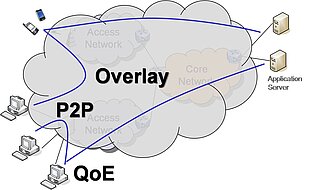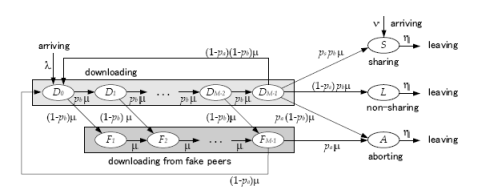Modeling of Application and User Behavior

Future Internet Applications & Overlays
| Head | ||
| Researchers | ||
| Student Helpers | Oskar Smietanka |

Modeling of Application and User Behavior
Edge-based Applications
In future Internet,multi-network services correspond to a new paradigm that intelligence in network control is gradually moved to the edge of the network. As a consequence, the application itself can influence or determine the amount of consumed bandwidth. Thus the user behaviour may change dramatically. This impacts the Quality of Service (QoS) and the Quality of Experience (QoE). A selfish user or application tries to maximize its own QoE rather than to optimize the network QoS, in contrast to a legacy altruistic user. An example for an edge-based application is Skype VoIP. The behavior of Skype nicely demonstrates the way edge-based applications are intended to work. The current end-to-end QoS and QoE is measured and evaluated. Performance measures may be the processing power of the involved machines or the QoS of the connection, like packet loss or delay. The application reacts accordingly, e.g. by changing the voice codec, by adjusting the sender bandwidth, or by re-routing the call on application layer.
From an operator<92>s point of view, it will be an increasing challenge to cope with such new edge-based applications, which are already highly popular among the users for a variety of reasons. They offer good quality, are easy-to-use, and provide additional functionality like chatting and file transfer which was not available in traditional telephony services. However, as the traffic of these edge-based applications is transported via the Internet, there are no QoS guarantees. For a network operator, offering strict QoS and QoE guarantees and value-added services are crucial to compete with these applications.
User Impatience
In content distribution networks, a user is mainly interested in reliability and efficiency of the offered service and does not care about the underlying technology. The considered technology for realizing such a service can either be a traditional client/server (CS) architecture or a peer-to-peer (P2P) network. In CS, the capacity of the server is the bottleneck and has to be dimensioned in such a way that all requests can be accommodated at any time, while a P2P system does not burden a single server since the content is distributed in the network among sharing peers. However, corrupted or fake files may diminish the reliability of the P2P service due to downloading of useless contents. In both systems we assume that the user is willing to wait only for a limited time until the download completes.If the downloading process exceeds a patience threshold, the user will abort his attempt. We use these models to analyze the benefits and drawbacks of each architecture.We compare a CS system to P2P and evaluate the downloading time, success ratio, and fairness while considering flash crowd arrivals and corrupted contents. We use a fluid model to derive analytical models taking into account time-dependent behavior and flash-crowd effects. The analysis model can be applied for example to eDonkey-like P2P file-sharing networks or the OnlineTVRecorder.com service. The later one is a video delivery service in Germany as an example.



